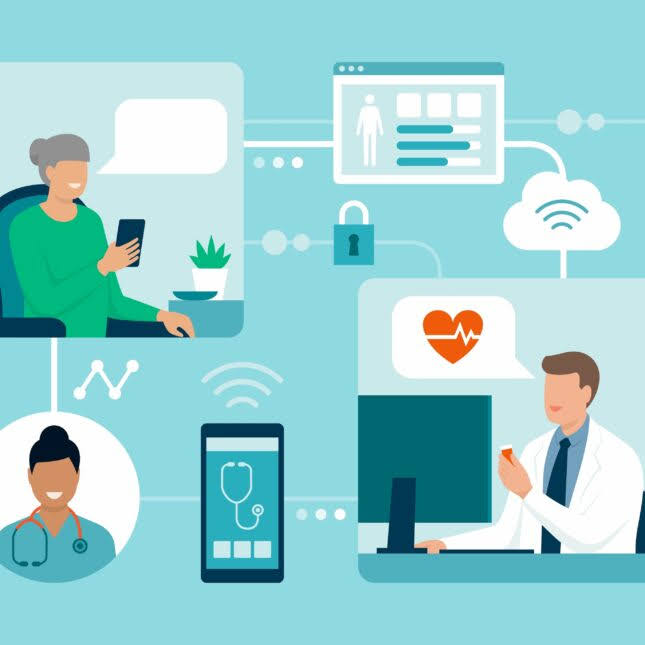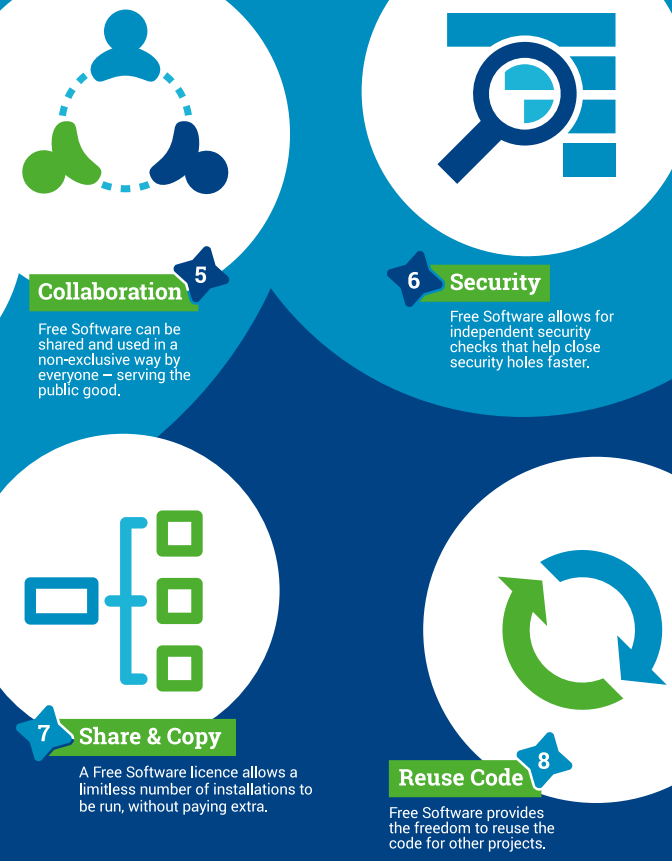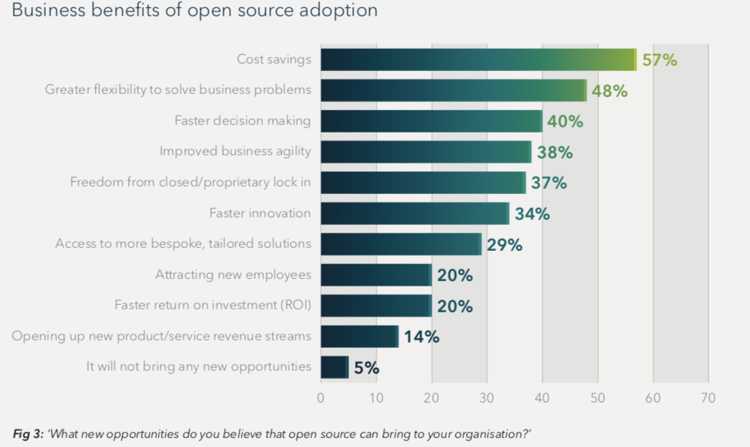Why is software created using taxpayers’ money not released as Free Software?
We want legislation requiring that publicly financed software developed for the public sector be made publicly available under a Free and Open Source Software license. If it is public money, it should be public code as well.
Code paid by the people should be available to the people!
REASONS FOR PUBLIC CODE

Stop Wasting Money
Similar applications don’t have to be programmed from scratch every time. There are 7 million open-source software developers donating their time to public projects.
Collaboration
Major projects can share expertise and costs between agencies and different governments.


Serve the Public Good
Applications paid by the public should be available for everyone. This would help improve the economy by reducing costs to businesses to redevelop software they’ve already paid for through taxes. Also, further improvements to software made by business for their own benefit would benefit everyone.
Accelerate Innovation
With transparent processes, others don’t have to reinvent the wheel. Progress will be much faster. This is especially important when it comes to medical research platforms that have the potential to save millions of lives.

Free Software gives everybody the right to use, study, share and improve software. This right helps support other fundamental freedoms like freedom of speech, press and privacy.
Do you believe that Free Software should be the default option for publicly financed software? Let’s convince your political representatives!
https://widget.civist.cloud/?api_url=https%3A%2F%2Fapi.civist.cloud%2Ft%2F196de6fd-9d84-49f7-8839-7e0599e3d288%2F#/RW1iZWRkaW5nOjExYTQ2NGMwLThlODgtNDI5MC1iZDI1LTc3YTRmMGFhNmRlMg==What is Open Source Software?
Source code is the human-readable form of a computer programming language. “Open source software” refers to licenses that require the source code to be available to users, and that users be able to reuse, modify, and distribute the code.
Benefits of Open Source Software


Requiring publicly funded software projects to be made open source software would increase the security of the people’s data, reduce initial and ongoing development costs, and improve functionality and user experience. It would also produce significant spillover benefits to society in that it would be available to other government entities and businesses to use for other purposes and contexts.
Today, we have a massive shortage of software developers. Yet, we have dozens of developers working in isolation in different companies writing the exact same code. Data has realized only a very tiny percentage of its potential to reveal hidden causes and new treatments for disease. This duplication of effort is a criminal waste of scarce cognitive power when there are so many people suffering and dying.
Without access to source code, researchers cannot effectively inspect, understand, or manipulate the inner workings of a program. Source code availability is of increased importance in the context of scientific research, where peer review, reproducibility, and building upon prior work are integral to the advancement of science.
Source code access helps researchers:
- identify and remedy bugs that might lead to errors in functionality
- identify and patch security holes
- adapt programs or pieces of code to suit individual needs
- allows expert users to contribute to code development on an informal basis
An active open source software user community participating in maintaining and improving the codebase can free the original developer to concentrate on major enhancements or move on to other projects without sacrificing the continued utility of the software.

Differences Between Open-Source and Proprietary Software
| Factor | Open-Source Software | Proprietary Software |
| Cost | Open-source software is free which makes it an alluring option if you have in-house capacities to meet your business requirements. | Proprietary software costs differently from a couple of thousand dollars to one hundred thousand dollars, depending upon the multifaceted nature of the framework needed. |
| Service and support | Open-source software communities of developers are huge and steadfast which helps clients with prompt solutions to their problems. | Proprietary software vendors offer progressing backing to clients- a key offering point for clients without specialized mastery. |
| Innovation | Open-source software boosts innovation by providing users the opportunity to modify, append, or distribute as per their requirements. | Proprietary software vendors don’t permit its users to view or adjust the source code, thus making it unfit for organizations who desire scalability and flexibility.Only developers can incorporate new features to the product as and when requested by users. |
| Security | As open-source code is available to everybody, it increases the possibility of finding more vulnerabilities easily. It is also worth noting that open-source communities fixed security vulnerabilities twice as quickly as commercial software vendors do. | Proprietary software is considered secure as it is developed in a governed condition of the employees having a frequent direction.However, getting rid of the possibility of backdoor Trojans as well as lowering the threat of any other bugs or obstacles can be troublesome in proprietary software. |
| Availability | Open-source software is available for free on the web often with 24*7 support from the community. | Proprietary software is accessible if the companies have the rights to the bundle or they have purchased from the respective vendors. The trial version is also accessible for free to test. |
| Flexibility | As organizations aim at deriving more business values from less, open-source software can deliver high flexibility, lower IT costs and increased opportunities for innovation. | With proprietary software, such as Microsoft Windows, and Office, companies are required to upgrade both software and hardware on a timely basis. Updates must be installed for the proper working. However, not all updates are flexible with all the versions of the software. |
Protecting the People’s Data
Cyberattacks are at an all-time high with 8.5 billion records breached in 2019 and ransomware attacks up 67% annually in Q4 2019. Attacks on operational technology infrastructure increased by 2,000%. This is just the tip of the iceberg of the continual data leakage we never get to hear about.
Myth: Proprietary software are secure and not prone to attacks
The majority of successful ransomware attacks on the government have been made against closed-source proprietary software. Two of many examples include:
- Melissa Virus and ILoveYou Worm spread through Microsoft Word email attachments. The email contained an attachment. If the victim’s system had the Microsoft outlook application installed, then the virus would send the email to 50 to all contacts in the Outlook program’s address book. would also overwrite & consequently destroy various types of files on the victim’s device including MP3 files, JPEG files, and more. It led Microsoft to shut down its inbound email system.
- Wannacry was a ransomware crypto worm attack that aimed at computers using Windows operating systems, encrypting all the files on hard drives on these machines. It didn’t let users access the files until they paid a ransom in the cryptocurrency Bitcoin. The WannaCry attack impacted major entities all over the world, such as the National Health Service in Britain and Scotland, the University of Montreal in Canada, State Government websites in India, and Russian Railways.
These attacks not only damaged vital electronic data but also shut down business operations and services, and facilitated malicious infiltration and theft of money & proprietary information.
Government systems handle really important information. Proprietary vendors have shown over and over again that they simply are not able to devote the resources required to keep systems updated and secured indefinitely.
The government has a lot of information on all of us, and collecting it also collects the responsibility to protect it. That just isn’t possible with hidden black-box proprietary software.
Leveraging Open Source Software for Innovation
In every major technology category, from operating systems to applications and data management, we see an open approach fueling innovation. For instance, in the last decade or two, a sprawl of proprietary server operating systems (OS) caused management issues. Today, on the other hand, almost 68% of servers run Linux, which is an open-source operating system. Similarly, open source software is used in over 40% of applications and data projects.
Why This Would Help Eradicate Dementia and Mental Illness
This initiative would be tremendously beneficial for our foundation’s mission of eradicating dementia and mental illness for several reasons:
- It would enable collaboration and cost-sharing between government agencies, allowing major medical research platforms and applications to be developed at a lower overall cost. Our foundation could partner with public entities in building and improving open-source software for dementia and mental health research.
- Open-source medical software would facilitate transparency, reproducibility, and peer review of studies and analyses. This is critical for advancing medical understanding as rapidly as possible.
- An open-source approach could help accelerate innovation in early diagnosis and treatment tools for dementia. Rather than reinventing the wheel, researchers could build on and improve shared open-source code.
- Open-source software developed with public funds best serves the public good. Releasing the code openly aligns with our mission of eradicating these diseases to reduce human suffering worldwide.
- Open-source software enables bugs and security vulnerabilities to be identified and fixed collaboratively. Protecting sensitive health data must be a top priority, and transparency facilitates this.
In summary, the Public Money Public Code initiative would be tremendously beneficial for our foundation’s goal of eradicating dementia, mental illness, and human suffering. We should fully support this initiative’s passage and identify opportunities to collaborate with government agencies on open-source medical research software.
Sources
- https://securityintelligence.com/posts/open-source-cybersecurity/
- https://us-cert.cisa.gov/ncas/alerts/aa20-302a
- https://www.srijan.net/blog/open-source-vs-proprietary-software-which-one-is-more-secure
- https://www.csiac.org/journal-article/publicly-releasing-open-source-software-developed-for-the-u-s-government/
- https://www.ncbi.nlm.nih.gov/pmc/articles/PMC3406002/
- https://www.dhs.gov/sites/default/files/publications/Open%20Source%20Software%20in%20Government%20%E2%80%93%20Challenges%20and%20Opportunities_Final.pdf
- https://www.linuxjournal.com/content/if-software-funded-public-source-its-code-should-be-open-source
- https://publiccode.eu/
- https://stackoverflow.com/questions/262255/why-isnt-all-government-sponsored-software-open-source/262621
- https://www.quora.com/Why-dont-governments-fund-the-development-of-open-source-software-very-much
- https://news.ycombinator.com/item?id=19077913

Leave a Reply